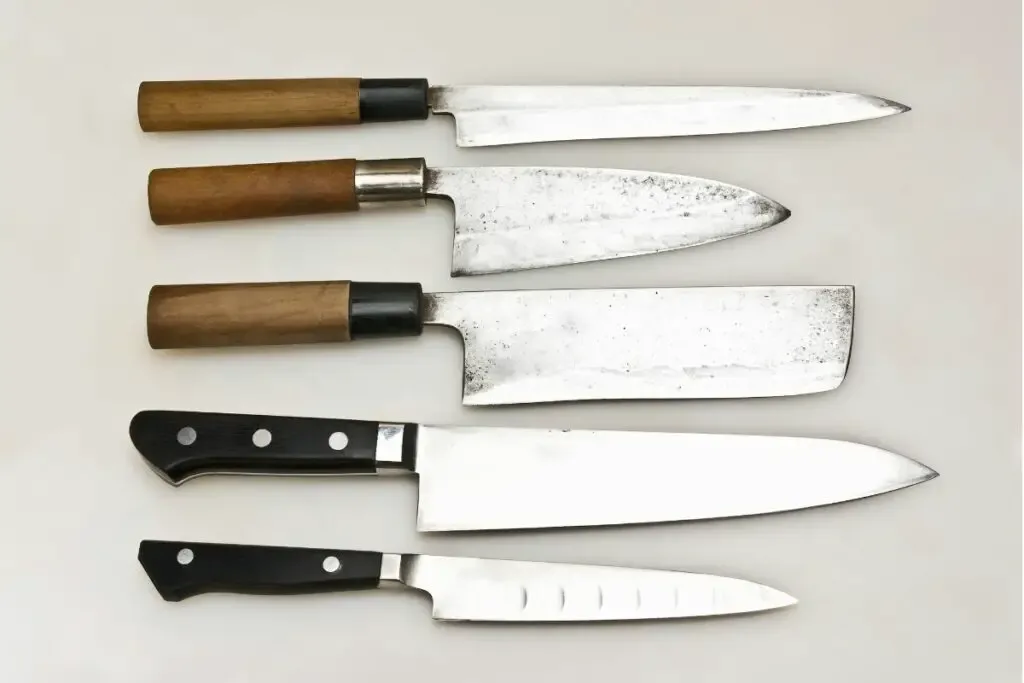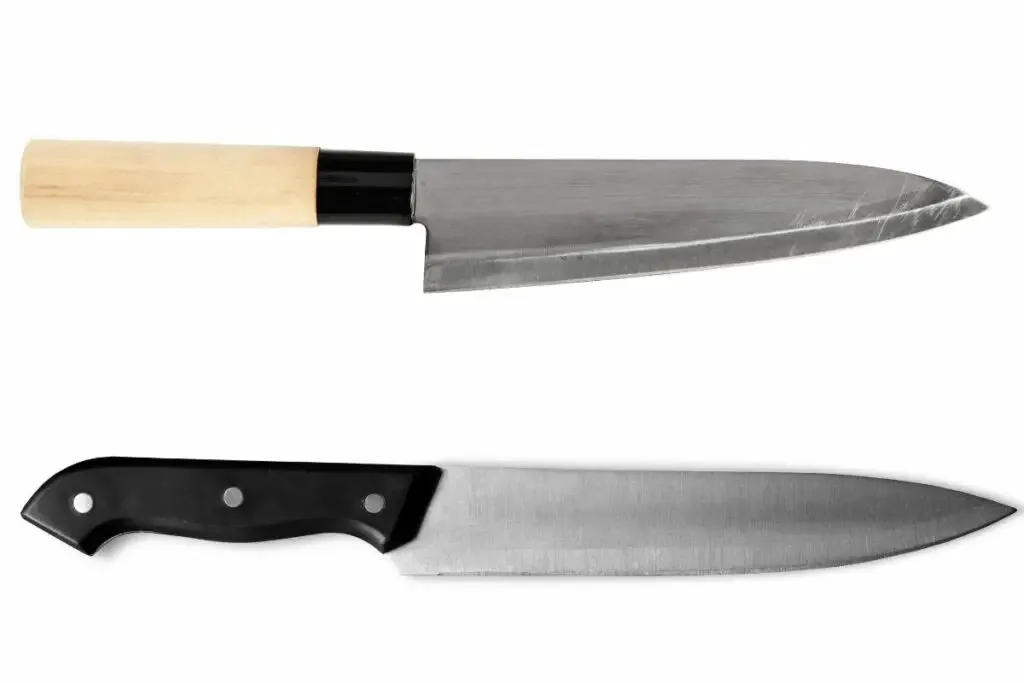As an Amazon Associate, we earn from qualifying purchases with no additional costs for you.
Japanese knives are highly sought after by both professional chefs and amateur home cooks alike for their superior sharpness, durability, and intricate designs. These knives have a long history in Japan and have been used for centuries in traditional Japanese cuisine. But what can you expect to pay for a Japanese knife?
The cost of A Japanese knife can vary from $50 up to $500 depending on the size of the knife, its intended purpose, the quality of the steel, the handle material, the manufacturing process, and the brand. Japanese knives are generally more expensive than their Western counterparts.
We will explore the main factors that affect the cost of Japanese knives, the various types of Japanese knives, and their average costs. We will also compare Japanese knives to their Western counterparts and provide tips on choosing the best Japanese knife for your needs and budget.
If you are interested in checking out the best Japanese knives (made by Hayate Yoshihiro) we recommend and use you can find them by clicking here (Amazon link).
What Is The Price For A Japanese Knife?

In Japanese cooking, a good quality knife is considered essential for achieving precision cuts and maximizing the flavor and texture of ingredients. Japanese knives are specifically designed to meet the unique needs of Japanese cuisine, which often involves delicate cuts of fish, vegetables, and meats.
Japanese knives have gained popularity in Western kitchens as well because of the quality, sharpness, and precision of these knives. These knives can be pricey, so how do you know the right price for these quality kitchen knives?
Whether you are a professional chef or a home cook looking to invest in a high-quality knife, our guide will provide you with all the information you need to make an informed decision.
Factors That Affect The Price Of Japanese Knives
Several factors can significantly affect the price of a Japanese knife. We have listed some of the important factors affecting these knives’ pricing.
- Materials used. The type of steel and other materials used to make the blade and handle of a Japanese knife can significantly affect its price. High-quality Japanese knives often feature hard-wearing steel with high carbon content, which is costly to produce and highly sought after for its superior edge retention and sharpness.
- Craftsmanship and production methods. Japanese knives often use traditional hand-forging methods requiring significant skill, time, and expertise. As a result, the knives produced through these methods can be much more expensive than those made using machine-based production methods.
- Brand reputation. Like with any product, the brand of a Japanese knife can significantly affect its price. Established and reputable brands that have been making high-quality knives for many years can command premium prices for their products.
- Rarity and uniqueness of the knife. Some Japanese knives are made in limited editions or feature unique designs, which can make them highly sought after and, therefore, more expensive.
Understanding these factors will help you better assess the value of a Japanese knife and make an informed decision about which knife to purchase based on your individual needs and budget.
TIP: Did you know that traditional handles on Japanese kitchen knives are designed to be replaced? Find out how to replace the handles on your Japanese knives with our comprehensive guide!
7 Simple Steps: How To Replace A Japanese Knife Handle
Types Of Japanese Knives And Their Average Costs

There are several different types of Japanese knives, each designed for a specific purpose. The prices often vary depending on the size of the knife and the knife’s intended purpose.
Here are some of the most popular types of Japanese knives and their average costs:
- Gyuto. This is the Japanese equivalent of a chef’s knife and is one of the most versatile knives you can own. The price typically ranges from $100 to $300, depending on the steel quality and craftsmanship.
- Santoku. This all-purpose knife is similar to a Gyuto but has a shorter and wider blade. It is suitable for chopping, slicing, and mincing various ingredients. It usually costs between $80 to $200.
- Deba. This knife is a traditional Japanese fish and meat cleaver. It is thick and heavy, making it ideal for breaking down fish and poultry bones. It can range from $80 to $300.
- Yanagiba. This knife is commonly used in sushi restaurants to cut raw fish into thin slices. It has a long, narrow blade and costs between $100 to $500.
- Petty. This small utility knife is ideal for peeling, trimming, and slicing small fruits and vegetables. It typically costs between $50 to $150.
- Usuba. This vegetable knife is used to cut thin, delicate slices of vegetables. It has a straight, thin blade and costs between $100 to $300.
It is important to note that these prices are average costs and can vary based on the materials used, craftsmanship, brand, and rarity of the knife. However, by understanding the different types of Japanese knives and their average costs, you can determine which knife is the best value for your needs and budget.
TIP: Each type of Japanese knife is designed and built with specific characteristics to fulfill a particular purpose in the kitchen. Find out a detailed explanation of all Japanese knives in the article below:
All Japanese Knife Types Explained (Purpose, Usage & More)
Comparison Of Japanese Knives To Western Knives

Japanese knives differ significantly from Western knives in their design, materials, and function. These differences affect the cost of Western knives and the suitability of the knives for specific tasks compared to Japanese kitchen knives.
The following are some of the key differences.
- Blade shape. Japanese knives often have a straighter and thinner blade than Western knives. This allows for a sharper edge and more precise cuts.
- Cutting edge angle. Japanese knives have a steeper angle of approximately 15 degrees, while Western knives have a more shallow angle of approximately 20 degrees. This allows for a sharper edge and more delicate cuts.
- Steel quality. Japanese knives often use harder steel with higher carbon content, which allows for a sharper edge and better edge retention. On the other hand, Western knives tend to use softer steel, which is more durable but less sharp.
- Handle design. Japanese knives often feature a traditional Japanese handle made of wood, while Western knives often have a full tang and a handle made of plastic or composite materials.
- Production method. Many Western knives are mass-produced in factories, while many Japanese knife manufacturers use traditional methods, which are more labor-intensive but produce better quality products. The handmade quality of Japanese knives increases their comparative cost.
- Function. Japanese knives are specifically designed for the precision cutting of fish, vegetables, and meats in Japanese cuisine. Western knives are more versatile and can be used for a wide range of kitchen cutting tasks.
Regarding price, Japanese knives tend to be more expensive than Western knives due to their high-quality materials, craftsmanship, and design. However, investing in a high-quality Japanese knife can be well worth the cost for those serious about cooking and wanting the best possible tool for the job.
TIP: If you are interested in buying a Japanese knife, we recommend these knives (Amazon links):
- Santoku: Yoshihiro NSW Hammered Damascus Santoku
- Gyuto: Yoshihiro VG-10 Hammered Damascus Gyuto
- Nakiri: Yoshihiro Hammered Damascus Nakiri
Tips On How To Choose A Japanese Knife
Choosing the right Japanese knife can be challenging, especially if you are unfamiliar with the available types and brands. Here are some tips to help you choose the best Japanese knife for your needs and budget.
- Determine your needs. Consider the food types you will be processing most frequently and what tasks you will be performing with your knife. This will help you determine which type of Japanese knife is best suited to your needs.
- Consider your budget. Japanese knives can range from less than $50 to over $1,000, depending on the materials, craftsmanship, and rarity of the knife. Determine your knife budget before you start shopping to avoid overspending.
- Research brands and models. Look for reputable brands with a long history of producing high-quality Japanese knives. Read reviews and compare prices to find the best value for your money.
- Test the knife before you buy. Whenever possible, try out the knife before you buy it. This will allow you to feel the weight and balance of the knife and ensure that it feels comfortable and easy to use.
- Consider maintenance. Japanese knives require special care and maintenance to keep them in good condition. Consider the upkeep required for the knife before you buy it to ensure that you are willing to invest the time and effort required to maintain it.
- Check the blade material. Japanese knives are generally made from high-carbon steel or stainless steel. High-carbon steel is harder and holds a sharper edge but requires more maintenance, while stainless steel is easier to maintain but may not hold an edge as well.
- Look for a comfortable handle. The handle should feel comfortable in your hand and provide a good grip. Traditional Japanese knives have a wooden handle, while some modern knives may have a synthetic or composite handle.
- Consider the blade shape and size. Different types of Japanese knives have different blade shapes and sizes. Choose a blade shape and size appropriate for the tasks you will be performing.
By following these tips, you can find the best Japanese knife for your needs and budget and ensure that you are investing wisely in a high-quality kitchen tool.
TIP: Did you know that the steel used in Japanese knives is what sets them apart from other knives? Find out all about the steel used in Japanese knives here!
Japanese Knives Steel Types (Complete List with Explanation)
Conclusion
Japanese knives are renowned for their high-quality materials, craftsmanship, and unique design, which sets them apart from Western knives. While the price of a Japanese knife can be higher than that of a Western knife, the investment can be well worth it for those who are serious about cooking and want the best possible tool for the job.
When choosing a Japanese knife, it is important to consider factors such as your budget, the types of food you will be cutting, the blade material, handle comfort, and maintenance requirements. By taking the time to research and test out different options, you can find a Japanese knife that is tailored to your needs and will provide years of use and enjoyment in the kitchen.
TIP: Japan is known for its quality kitchen knives, but did you know that Japanese pocket knives are every bit as exotic as kitchen knives? Read all about Japanese pocket knives here!
Japanese Pocket Knife: Explore Its Unique Features and Uses
